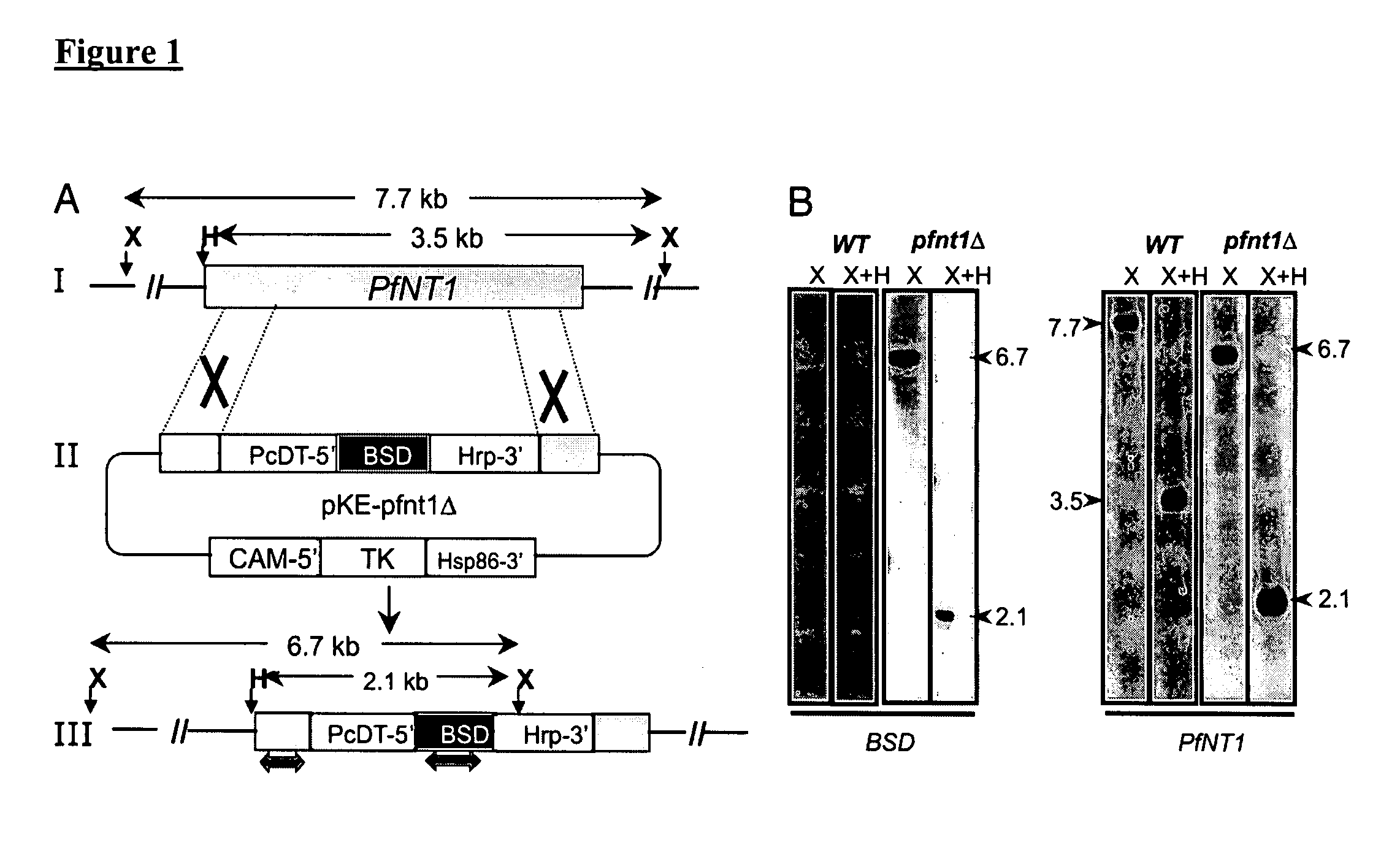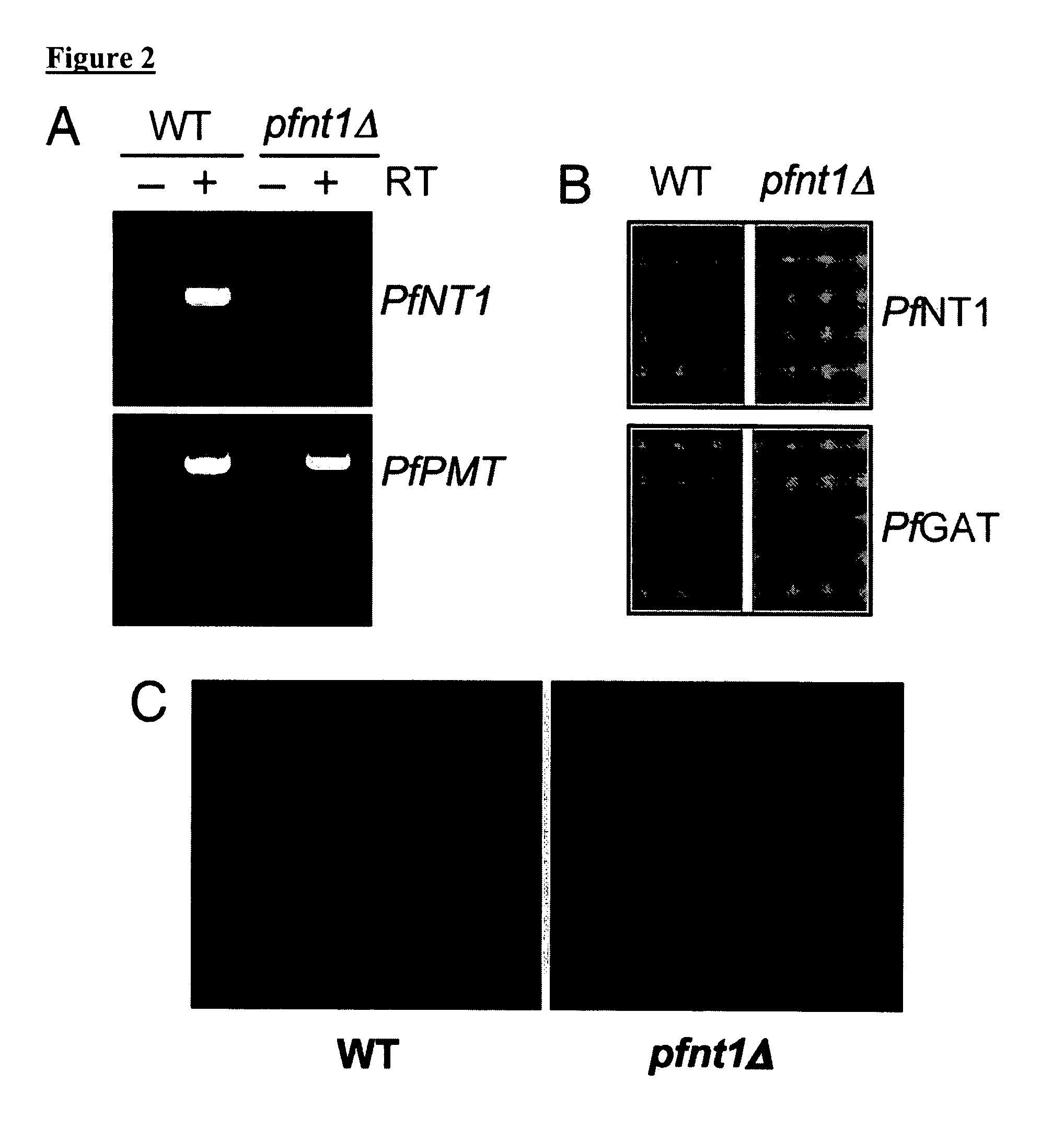Use of conditional plasmodium strains lacking nutrient transporters in malaria vaccination
a technology of conditional plasmodium strains and malaria vaccines, which is applied in the field of development and use of attenuated strains of malarial parasites, to achieve the effects of reducing the risk of malaria infection
- Summary
- Abstract
- Description
- Claims
- Application Information
AI Technical Summary
Benefits of technology
Problems solved by technology
Method used
Image
Examples
example 1
Disruption of the PfNT1 Gene in pKEΔPfNT Parasites
[0091] To evaluate the importance of PFNT1 in parasite development and survival, the generation of transgenic parasites lacking PfNT1 was attempted by a targeted gene replacement approach (Duraisingh, M. T., Triglia, T. & Cowman, A. F. (2002) Int J Parasitol, 32, 81-9). To achieve this goal, a targeting vector pKEΔPfNT was constructed (FIG. 1A). The overall knockout strategy entails a two step process by which PfNT1 is first interrupted with the blasticidin-s-deaminase (BSD) (Mamoun, C. B., Gluzman, I. Y., Goyard, S., Beverley, S. M. & Goldberg, D. E. (1999) Proc Natl Acad Sci USA, 96, 8716-20) cassette after a double cross-over event (FIG. 1A) followed by loss of the episome after selection against thymidine kinase (TK) gene expression. This targeted gene disruption strategy with double cross-over caused a 255 bp truncation in the middle of the PfNT1 open reading frame (ORF). Since loss of PfNT1 was conjectured to be a potentially ...
example 2
Loss of Expression of PfNT1 in the pfnt1Δ Knockout
[0092] To demonstrate the loss of PfNT1 expression in a pfnt1Δ clone, RT-PCR analysis was performed on RNA purified from wild-type and knockout parasites using primers within the PfNT1 ORF. PfNT1 cDNA was amplified from wild-type but not pfnt1Δ RNA (FIG. 2A). Loss of PfNT1 expression was further analyzed by immunoblotting using affinity-purified anti-PfNT1 antibodies (Rager, N., Mamoun, C. B., Carter, N. S., Goldberg, D. E. & Ullman, B. (2001) J Biol Chem, 276, 41095-9). Whereas a 46 kDa PFNT1 band was detected in wild-type P. falciparum, no signal was identified in the pfnt1Δ parasites (FIG. 2B). As a loading control, antibodies raised against the parasite endoplasmic reticulum membrane protein PfGat (Santiago, T. C., Zufferey, R., Mehra, R. S., Coleman, R. A. & Ben Mamoun, C. (2004) J Biol Chem, 279, 9222-32) were used, and the expected 64 kDa PfGat band was observed in both the wild-type and pfnt1Δlysates (FIG. 2B). Immunofluores...
example 3
Purine Requirements for pfnt1Δ Parasites
[0093] To assess the role of PFNT1 in purine acquisition during the parasite intraerythrocytic life cycle, wild-type and pfnt1ΔP. falciparum were grown in the presence of increasing concentrations of hypoxanthine, adenosine or inosine, and parasite growth was monitored by measuring parasite LDH production. Whereas optimal growth was observed in wild-type parasites at purine concentrations of 5 μM and above, pfnt1Δ parasites were not viable in adenosine, inosine, or hypoxanthine at concentrations below 50 μM (FIG. 3A). To measure the impact of the pfnt1Δ lesion on parasite intraerythrocytic development, wild-type and pfnt1Δ cells were synchronized and cultured in the absence or presence of increasing concentrations of hypoxanthine. Parasite progression through the life cycle (ring>trophozoite>schizont>ring) was monitored at various times after erythrocyte invasion. For both strains lack of purine resulted in blockage of growth at the ring stag...
PUM
| Property | Measurement | Unit |
|---|---|---|
| pH | aaaaa | aaaaa |
| pH | aaaaa | aaaaa |
| plasma membrane | aaaaa | aaaaa |
Abstract
Description
Claims
Application Information
 Login to View More
Login to View More - R&D
- Intellectual Property
- Life Sciences
- Materials
- Tech Scout
- Unparalleled Data Quality
- Higher Quality Content
- 60% Fewer Hallucinations
Browse by: Latest US Patents, China's latest patents, Technical Efficacy Thesaurus, Application Domain, Technology Topic, Popular Technical Reports.
© 2025 PatSnap. All rights reserved.Legal|Privacy policy|Modern Slavery Act Transparency Statement|Sitemap|About US| Contact US: help@patsnap.com



